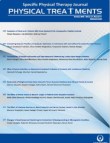Relationship between spinal abnormal deviations, low back pain and body mass index in female students
Abstract:
Objective
The present study designed to investigate the incidence of spinal deviations among the female students resident in Ashrafi Esfahani dormitory، the university of Social Welfare and Rehabilitation sciences in 2011 and to determine its relation to low back pain and Body Mass Index (BMI). Materials and Methods
In a prospective cross-sectional study 63 female students were randomly included. Before the main study، the reliability of measurements was evaluated. Following giving information about the study، data on background، Back problems and spinal deviations was collected through interviews، questionnaires and physical examination. Data Analyzed with SPSS software using the Pearson Chi-square test and Fisher Exact. Results
The reliability of results were acceptable. Most of quantitative data were consistent with a normal distribution. Out of 63 participants، 38. 1% with scoliosis، 27% hyperlordosis and 30. 2. % hypolordosis were determined. More than half (58. 7 %) of students reported low back pain with severity of 2. 19. The results of statistical analysis showed among the students with scoliosis، low back pain (LBP) were less common (27. 70%) in comparison with those without scoliosis (72. 29%); although this difference was not statistically significant. LBP were 37. 83% among individuals with hyperlordosis، 21. 63% among those with hypolordosis and 40. 54% among those with normal lordosis، this difference was significant (p<0. 05). Chi squere result revealed significat relation between LBP with lordosis among female students (p = 0. 04) and lordosis with scoliosis (p =0. 03)، but no significant relation was seen between scoliosis with back pain (p = 0. 08)، and Body Mass Index (BMI) with scoliosis (p =0. 68) and lordosis (12/0 p = 0. 12). Conclusion
Among the study population، scoliosis was more prevalent than hyperlordosis and hyperlordosis was more common than hypolordosis. Considering lack of any relation between scoliosis and LBP، scoliosis can be developed without any back pain symptom. And also considering higher prevalence of hyperlordosis and its positive relation to LPB in comparison to hypolordosis، screening، prevention and treatment strategies to specially prevent and&or reduce scoliosis and hyperlordosis are emphasized. This study was confimatory to the relation between scoliosis and lordosis but not confirmatory to the relation betweed BMI with scoliosis and lordosis.Language:
Persian
Published:
Physical Treatments Journal, Volume:2 Issue: 2, 2012
Pages:
49 to 55
magiran.com/p1235676
دانلود و مطالعه متن این مقاله با یکی از روشهای زیر امکان پذیر است:
اشتراک شخصی
با عضویت و پرداخت آنلاین حق اشتراک یکساله به مبلغ 1,390,000ريال میتوانید 70 عنوان مطلب دانلود کنید!
اشتراک سازمانی
به کتابخانه دانشگاه یا محل کار خود پیشنهاد کنید تا اشتراک سازمانی این پایگاه را برای دسترسی نامحدود همه کاربران به متن مطالب تهیه نمایند!
توجه!
- حق عضویت دریافتی صرف حمایت از نشریات عضو و نگهداری، تکمیل و توسعه مگیران میشود.
- پرداخت حق اشتراک و دانلود مقالات اجازه بازنشر آن در سایر رسانههای چاپی و دیجیتال را به کاربر نمیدهد.
In order to view content subscription is required
Personal subscription
Subscribe magiran.com for 70 € euros via PayPal and download 70 articles during a year.
Organization subscription
Please contact us to subscribe your university or library for unlimited access!


